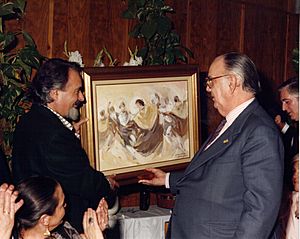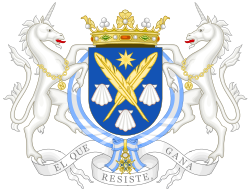Camilo José Cela facts for kids
Quick facts for kids
The Most Illustrious
Camilo José Cela
|
|
|---|---|
 |
|
| Born | Camilo José Cela y Trulock 11 May 1916 Iria Flavia, Galicia, Spain |
| Died | 17 January 2002 (aged 85) Madrid, Spain |
| Resting place | Iria Flavia cemetery |
| Occupation | Novelist, short story writer, essayist |
| Language | Spanish |
| Notable works | The Family of Pascual Duarte, The Hive |
| Notable awards | Nobel Prize in Literature 1989 |
| Spouse | María del Rosario Conde Picavea (m. 1944–div. 1990) Marina Concepción Castaño López (m. 1991–2002) (his death) |
| Children | Camilo José Cela Conde |
Camilo José Cela y Trulock, 1st Marquess of Iria Flavia (Spanish: [kamilo xoˈse ˈθela]; 11 May 1916 – 17 January 2002) was a Spanish novelist, poet, story writer and essayist associated with the Generation of '36 movement.
He was awarded the 1989 Nobel Prize in Literature "for a rich and intensive prose, which with restrained compassion forms a challenging vision of man's vulnerability".
Contents
Childhood and early career
Camilo José Cela was born in the rural parish of Iria Flavia, in Padrón, A Coruña, Spain, on 11 May 1916. He was the oldest child of nine. His father, Camilo Crisanto Cela y Fernández, was Galician. His mother, Camila Emanuela Trulock y Bertorini, was a Galician of English and Italian ancestry. The family was upper-middle-class and Cela described his childhood as being "so happy it was hard to grow up."
He lived with his family in Vigo from 1921 to 1925, when they moved to Madrid. There, Cela studied at a Piarist school. In 1931 he was diagnosed with tuberculosis and admitted to the sanatorium of Guadarrama, where he took advantage of his free time to work on his novel Pabellón de reposo. While recovering from the illness Cela began intensively reading works by José Ortega y Gasset and Antonio de Solís y Ribadeneyra.
The Spanish Civil War broke out in 1936 when Cela was 20 years old and just recovering from his illness. His political leanings were conservative and he escaped to the rebel zone. He enlisted himself as a soldier but was wounded and hospitalized in Logroño.
Career
The civil war ended in 1939; after the war, Cela became indecisive towards his university studies and ended up working in a bureau of textile industries. It was here where he began to write what would become his first novel, La familia de Pascual Duarte (The Family of Pascual Duarte), which was finally published when he was 26, in 1942. Pascual Duarte has trouble finding validity in conventional morality and commits a number of crimes, including murders, for which he feels nothing. The novel is of particular importance as it played a large part in shaping the direction of the post-World War II Spanish novel.
Cela became a censor in Francoist Spain in 1943. Perhaps his best-known work was produced during a period where his own writing came under scrutiny from his fellow censors, including La colmena (The Hive) which was published in Buenos Aires in 1951, having been banned in Spain. The novel features more than 300 characters and a style showing the influence of both Spanish realism and contemporary English and French-language authors. Cela's signature style—a sarcastic, often grotesque, form of realism—is epitomized in La colmena.
From the late 1960s, with the publication of San Camilo 1936, Cela's work became increasingly experimental. In 1988 he wrote Cristo versus Arizona (Christ versus Arizona), which tells the story of the Gunfight at the O.K. Corral in a single sentence that is more than one hundred pages long.
Legacy
On 26 May 1957, Cela was appointed a member of the Royal Spanish Academy and given Seat Q. He was appointed Royal Senator in the Constituent Cortes, where he exerted some influence in the wording of the Spanish Constitution of 1978. In 1987, he was awarded the Prince of Asturias Award for Literature.
Cela was awarded the Nobel Prize in Literature in 1989 "for a rich and intensive prose, which with restrained compassion forms a challenging vision of man's vulnerability".
In 1994, he was awarded the Premio Planeta, although some question the objectivity of the awards, and winners on occasion have refused to accept it. Two years later, in recognition of his contributions to literature, Cela was ennobled on 17 May 1996 by King Juan Carlos I, who gave Cela the hereditary title of Marquess of Iria Flavia in the nobility of Spain. On his death the title passed to his son Camilo José Cela Conde.
Death
Cela died from heart disease on 17 January 2002 at the Hospital Centro in Madrid, aged 85. He was buried in his hometown at the parish cemetery of Santa María de Adina.
Cela's will was contested because he favoured his widow and second younger wife, Marina Castaño, over his son Camilo José Cela Conde from his first marriage to Rosario Conde.
Selected works
Spanish
Novels
- La familia de Pascual Duarte. Madrid: Aldecoa. 1942.
- Pabellón de reposo. Madrid: Afrodisio Aguado. 1943.
- Nuevas andanzas y desventuras de Lazarillo de Tormes. Madrid: La Nave. 1944.
- La colmena. Buenos Aires: Emecé. 1951.
- Mrs. Caldwell habla con su hijo. Barcelona: Destino. 1953.
- La catira. Barcelona: Noguer. 1955. (Also published under the title Historias de Venezuela.)
- Tobogán de hambrientos. Barcelona: Noguer. 1962.
- Vísperas, festividad y octava de San Camilo del año 1936 en Madrid. Madrid: Alfaguara. 1969.
- Oficio de tinieblas 5. Barcelona: Noguer. 1973.
- Mazurca para dos muertos. Barcelona: Seix Barral. 1983. https://archive.org/details/mazurcaparadosmu0000cela.
- Cristo versus Arizona. Barcelona: Seix Barral. 1988. ISBN 9788432205828. https://archive.org/details/cristoversusariz0000cela.
- Oficio de tinieblas 5. Barcelona: Plaza & Janés. 1989. ISBN 9788401381485. https://archive.org/details/oficiodetiniebla0000cela.
- La cruz de San Andrés. Barcelona: Planeta. 1994.
- Madera de boj. Madrid: Espasa-Calpe. 1999. ISBN 9788423979615. https://archive.org/details/maderadeboj00cela.
Short-story collections
- El bonito crimen del carabinero, y otras invenciones. Barcelona: José Janés. 1947.
- El gallego y su cuadrilla. Madrid: Ricardo Aguilera. 1949.
- Baraja de invenciones. Valencia: Castalia. 1953.
- El molino de viento y otros novelas cortas. Barcelona: Noguer. 1956.
- Nuevo retablo de Don Cristobita: Invenciones, figuraciones y alucinaciones. Barcelona: Destino. 1957.
Drama and poetry collections
- Pisando la dudosa luz del dia. Barcelona: Ed. del Zodíaco. 1945.
- Cancionero de la Alcarria. San Sebastían: Norte. 1948.
- María Sabina. Palma de Mallorca: Papeles de Son Armadans. 1967.
- El caro de heno o El inventor de la guillotina. Palma de Mallorca: Papeles de Son Armadans. 1969.
- María Sabina; El carro de heno o El inventor de la guillotina (2d ed.). Madrid: Alfaguara. 1970.
- Poesía completa. Barcelona: Círculo de lectores. 1996.
- La extracción de la piedra de la locura o El inventor del garrote. Barcelona: Seix Barral. 1999.
Travel writing
- Viaje a la Alcarria. MadridBarcelona: Revista de Occidente. 1948.
- Avila. Barcelona: Noguer. 1952.
- Del Miño al Bidasoa: Notas de un vagabundaje. Barcelona: Noguer. 1952.
- Vagabundo por Castilla. Barcelona: Seix Barral. 1955.
- Judíos, moros y cristianos: Notas de un vagabundaje por Avila, Segovia y sus tierras. Barcelona: Destino. 1956.
- Primer viaje andaluz : notas de un vagabundaje por Jaén, Córdoba, Sevilla, Segovia, Huelva y sus tierras. Barcelona: Noguer. 1959.
- Viaje al Pirineo de Lérida : notas de un paseo a pie por el Pallars, Sobirá, el Valle de Arán y el Condado de Ribagorza. Madrid: Alfaguara. 1965.
- Nuevo viaje a la Alcarria. Barcelona: Plaza & Janés. 1986.
Essays
- Mesa revuelta. Madrid: Ediciones de los Estudiantes Españoles. 1945.
- Cajón de sastre. Madrid: Cid. 1957.
- La rueda de los ocios. Barcelona: Mateu. 1957.
Criticism
- Cuatro figuras del 98: Unamuno, Valle-Inclán, Baroja, Azorín, y otros retratos y ensayos españoles. Barcelona: Aedos. 1961.
Memoirs
- La cucaña: Memorias de Camilo José Cela. Barcelona: Destino. 1959.
- Memorias, entendimientos y voluntades. Barcelona: Plaza & Janés. 1993.
Correspondence
- Correspondencia con el exilio. Barcelona: Destino. 2009. (Cela's correspondence with 13 exiled Spanish writers: María Zambrano, Rafael Alberti, Américo Castro, Fernando Arrabal, Jorge Guillén, Max Aub, Emilio Prados, Luis Cernuda, Manuel Altolaguirre, León Felipe, Corpus Barga, Francisco Ayala, Ramón J. Sender.)
- Correspondencia: Camilo José Cela, Antonio Vilanova. Barcelona: PPU. 2012.
Collected works
- Obra completa. Barcelona: Ediciones Destino. 1962. (Volumes published as completed since 1962.) Volume 1: Las tres primeras novelas (1942—44); Volume 2: Cuentos (1941—53); Volume 3: Apuntes carpetovetonicos. Novelas cortas (1941–56); Volume 4: Viajes por España, 1 (1948—52); Volume 5: Viajes por España, 2 (1952—58); Volume 6: Viajes por España, 3 (1959—64)l Volume 7: Tres novelas más (1951—55); Volume 8: Los amigos y otra novela (1960—62); Volume 9: Glosa del mundo en torno. Articulos, 1. (1940—53). Mesa revuelta. 5. ed.; Volume 10: Glosa del mundo en torno. Articulos, 2. (1944—59). Cajón de sastre. 4. ed; Paginas de geografía errabunda. 3. ed.; Volume 1:. Glosa del mundo en torno. Artʹiculos, 3 (1945-1954). Las compañías convenientes y otros fingimientos y cegueras. 3a ed. Garito de hospicianos o Guirigay de imposturas y bambollas. 4a ed.; Volume 12: Glosa del mundo en torno. Artículos, 4 (1943—61). La rueda de los ocios. 4a ed. Cuatro figuras del 98. 2a ed.; Volume 14: Enciclopedia del erotismo, 1. Aachen—Cirene; Volume 15: Enciclopedia del erotismo, 1. Cirial—Futrʹosofo; Volume 16: Enciclopedia del erotismo, 3. Gabacho—Óvulo; Volume 17: Enciclopedia del erotismo, 4. Pabst—Zurrucarse.
- Olivia Rodríguez González, ed. (2006). Retorno a Iria Flavia: obra dispersa y olvidada, 1940-2001. Santiago de Compostela: Alvarellos Editora.
English translations
- Pascual Duarte's family. London: Eyre & Spottiswoode. 1946.
- The Hive. New York: Farrar, Straus and Young. 1953. (Reprinted: New York: New York: Noonday Press, 1990.) Translation of La colmena.
- The Family of Pascual Duarte. Boston: Little, Brown. 1964.
- Journey to the Alcarria. Madison, Wisconsin: University of Wisconsin Press. 1964. https://archive.org/details/journeytoalcarri0000cela. Translation of Viaje a la Alcarria.
- Pascual Duarte and His Family. New York: Las Americas Pub. Co.. 1965.
- Mrs. Caldwell Speaks to Her Son. Ithaca, N.Y.: Cornell University Press. 1968. https://archive.org/details/mrscaldwellspeak00cela. Authorized translation of Mrs. Caldwell habla con su hijo.
- San Camilo, 1936: The Eve, Feast, and Octave of St. Camillus of the year 1936 in Madrid. Durham: Duke University Press. 1991. Translation of Visperas, festividad y octava de San Camilo del año 1936 en Madrid.
- Mazurka for Two Dead Men. New York: New Directions. 1992. ISBN 9780811212229. https://archive.org/details/mazurkafortwodea00cela. Translation of Mazurca para dos muertos.
- Boxwood. New York: New Directions. 2002. Translation of Madera de boj.
- Christ Versus Arizona. Champaign: Dalkey Archive Press. 2007.
See also
 In Spanish: Camilo José Cela para niños
In Spanish: Camilo José Cela para niños
- Journey to the Alcarria
- Café Gijón (Madrid)
- Universidad Camilo José Cela



